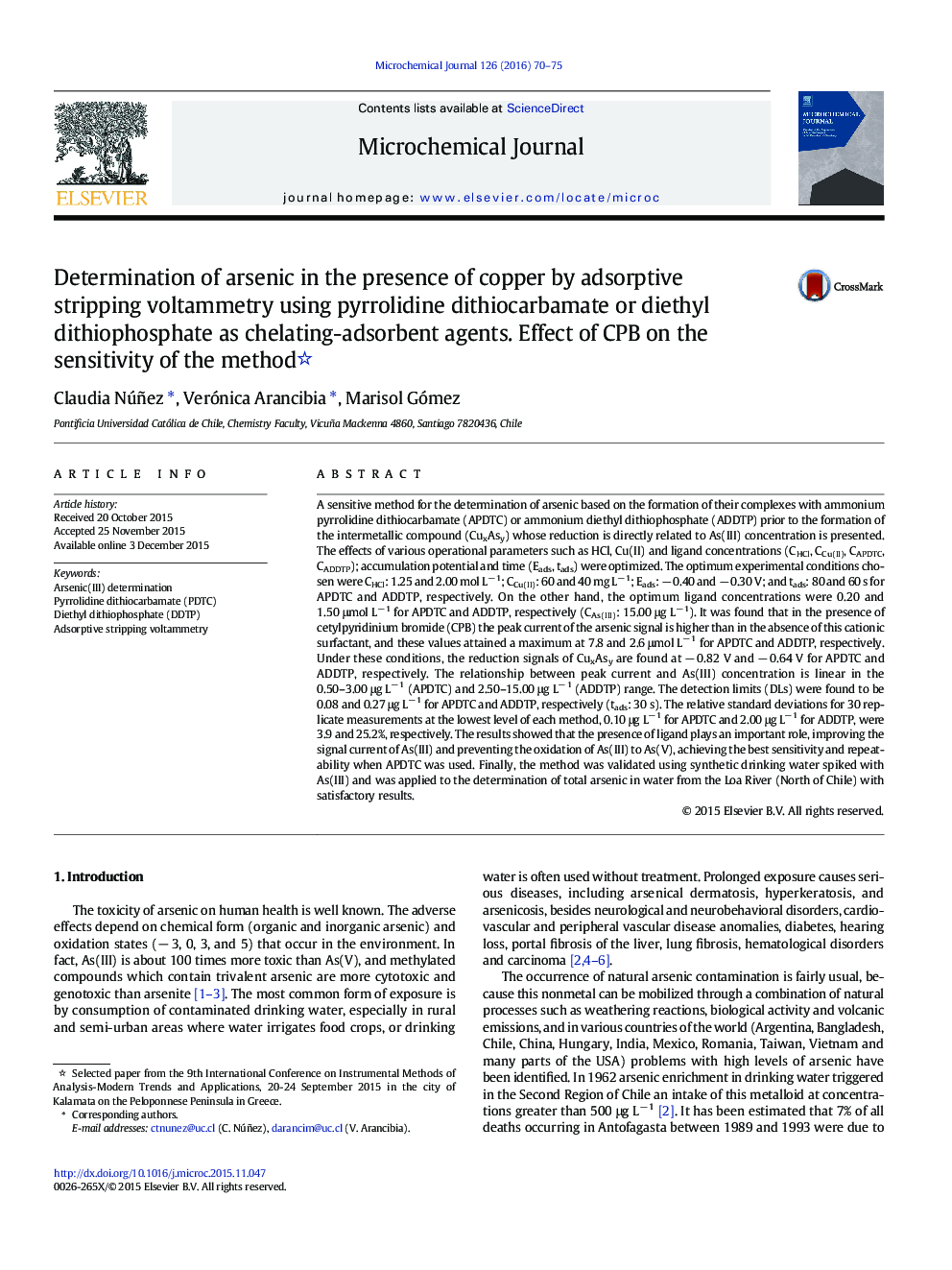| کد مقاله | کد نشریه | سال انتشار | مقاله انگلیسی | نسخه تمام متن |
|---|---|---|---|---|
| 7641436 | 1494868 | 2016 | 6 صفحه PDF | دانلود رایگان |
عنوان انگلیسی مقاله ISI
Determination of arsenic in the presence of copper by adsorptive stripping voltammetry using pyrrolidine dithiocarbamate or diethyl dithiophosphate as chelating-adsorbent agents. Effect of CPB on the sensitivity of the method
دانلود مقاله + سفارش ترجمه
دانلود مقاله ISI انگلیسی
رایگان برای ایرانیان
کلمات کلیدی
موضوعات مرتبط
مهندسی و علوم پایه
شیمی
شیمی آنالیزی یا شیمی تجزیه
پیش نمایش صفحه اول مقاله

چکیده انگلیسی
A sensitive method for the determination of arsenic based on the formation of their complexes with ammonium pyrrolidine dithiocarbamate (APDTC) or ammonium diethyl dithiophosphate (ADDTP) prior to the formation of the intermetallic compound (CuxAsy) whose reduction is directly related to As(III) concentration is presented. The effects of various operational parameters such as HCl, Cu(II) and ligand concentrations (CHCl, CCu(II), CAPDTC, CADDTP); accumulation potential and time (Eads, tads) were optimized. The optimum experimental conditions chosen were CHCl: 1.25 and 2.00 mol Lâ 1; CCu(II): 60 and 40 mg Lâ 1; Eads: â 0.40 and â 0.30 V; and tads: 80 and 60 s for APDTC and ADDTP, respectively. On the other hand, the optimum ligand concentrations were 0.20 and 1.50 μmol Lâ 1 for APDTC and ADDTP, respectively (CAs(III): 15.00 μg Lâ 1). It was found that in the presence of cetylpyridinium bromide (CPB) the peak current of the arsenic signal is higher than in the absence of this cationic surfactant, and these values attained a maximum at 7.8 and 2.6 μmol Lâ 1 for APDTC and ADDTP, respectively. Under these conditions, the reduction signals of CuxAsy are found at â 0.82 V and â 0.64 V for APDTC and ADDTP, respectively. The relationship between peak current and As(III) concentration is linear in the 0.50-3.00 μg Lâ 1 (APDTC) and 2.50-15.00 μg Lâ 1 (ADDTP) range. The detection limits (DLs) were found to be 0.08 and 0.27 μg Lâ 1 for APDTC and ADDTP, respectively (tads: 30 s). The relative standard deviations for 30 replicate measurements at the lowest level of each method, 0.10 μg Lâ 1 for APDTC and 2.00 μg Lâ 1 for ADDTP, were 3.9 and 25.2%, respectively. The results showed that the presence of ligand plays an important role, improving the signal current of As(III) and preventing the oxidation of As(III) to As(V), achieving the best sensitivity and repeatability when APDTC was used. Finally, the method was validated using synthetic drinking water spiked with As(III) and was applied to the determination of total arsenic in water from the Loa River (North of Chile) with satisfactory results.
ناشر
Database: Elsevier - ScienceDirect (ساینس دایرکت)
Journal: Microchemical Journal - Volume 126, May 2016, Pages 70-75
Journal: Microchemical Journal - Volume 126, May 2016, Pages 70-75
نویسندگان
Claudia Núñez, Verónica Arancibia, Marisol Gómez,